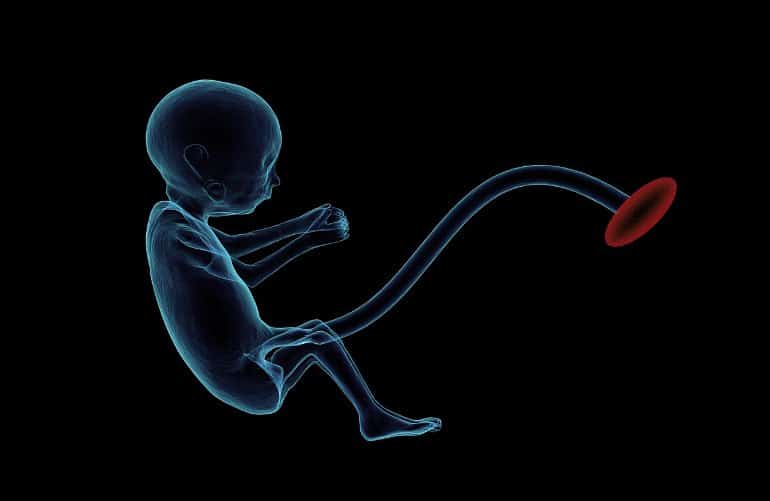Summary: Study reveals significant changes in the expression of multiple genes in the placenta associated with exposure to UFP air pollution. Additionally, researchers reported noticeable reductions in fetal and placental length, and fetal weight in those with low dose UFP exposure.
Source: Texas A&M
Polluted air contributed to the deaths of more than 6.6 million people worldwide in 2019. It accounts for around 20 percent of newborn deaths globally, mostly due to preterm birth and low birth weight. Because of this, it is crucial that researchers and policymakers working to improve public health understand how different aspects of various types of air pollution and their associated biological responses affect fetal development.
To add to this understanding, researchers at Texas A&M University and other institutions conducted a study of air pollution’s effects on fetal development in an experimental model.
In the study, published in the journal Toxicological Sciences, recent Texas A&M School of Public Health doctoral candidate Jonathan Behlen, associate professor Natalie Johnson, and colleagues analyzed the effects of exposure to different concentrations of ultrafine particles (UFPs) on fetal development and how exposure affected expression of certain genes in the placenta.
Particulate matter is a major type of air pollution that consists of particles suspended in the air. The smallest of these particles, UFPs, are smaller than 100 nanometers. A growing body of evidence is pointing to UFPs having harmful effects during pregnancy; however, there is less certainty about what mechanisms are involved in these adverse outcomes.
The researchers analyzed the effects of UFPs in an experimental animal model. Pregnant models were placed in three groups: one with filtered air, one with low dose UFPs and one with high dose UFPs. The models were exposed to a mixture of UFPs typically found in cities, the low dose below regulatory standards for PM2.5. The researchers then measured placentas and fetuses of pregnant female models and analyzed changes in gene expression from placental tissues. Specifically, the researchers found altered expression of genes responsible for antioxidant, inflammatory and lipid transport activities.
Behlen, Johnson and colleagues found that the low dose group had notable reductions in fetal and placental length and decreasing trends in fetal weight for both male and female fetuses. They also found changes in expression for multiple genes. The changes in gene expression were higher in the low dose group than the high dose group and were greater in female fetuses than male ones.
Their analysis also found increased expression of antioxidant and inflammatory genes in fetuses of both sexes in both dose groups as well as disruptions in genes responsible for lipid metabolism. Changes to how these genes are expressed could affect bodily processes in a way that increases the risks of adverse pregnancy outcomes like preeclampsia.

These findings indicate some of the biological underpinnings of how UFP exposure affects pregnancy; however, the researchers note that their study relied on analysis of many different cell types together. Future studies that focus on single cell types could further clarify the effects of UFPs on placental and fetal development. Additionally, the researchers identify a need for more in-depth analyses of possible mechanisms behind the differences they found between male and female fetuses.
The findings of this study align with other studies showing UFPs adversely affecting pregnancies. With more information on gene expression changes and other effects, scientists will have a better starting point for further study of exactly how air pollution impacts fetal development. Such an understanding could help inform efforts to mitigate the harmful effects of air pollution worldwide.
About this genetics and pollution research news
Author: Press Office
Source: Texas A&M
Contact: Press Office – Texas A&M
Image: The image is in the public domain
Original Research: Closed access.
“Gestational Exposure to Ultrafine Particles Reveals Sex- and Dose-Specific Changes in Offspring Birth Outcomes, Placental Morphology, and Gene Networks” by Jonathan C Behlen et al. Toxicological Sciences
Abstract
Gestational Exposure to Ultrafine Particles Reveals Sex- and Dose-Specific Changes in Offspring Birth Outcomes, Placental Morphology, and Gene Networks
Particulate matter (PM) causes adverse developmental outcomes following prenatal exposure, but the underlying biological mechanisms remain uncertain.
Here we elucidate the effects of diesel exhaust ultrafine particle (UFP) exposure during pregnancy on placental and fetal development. Time-mated C57Bl/6n mice were gestationally exposed to UFPs at a low dose (LD, 100 µg/m3) or high dose (HD, 500 µg/m3) for 6 h daily.
Phenotypic effects on fetuses and placental morphology at gestational day (GD) of 18.5 were evaluated, and RNA sequencing was characterized for transcriptomic changes in placental tissue from male and female offspring. A significant decrease in average placental weights and crown to rump lengths was observed in female offspring in the LD exposure group. Gestational UFP exposure altered placental morphology in a dose- and sex-specific manner. Average female decidua areas were significantly greater in the LD and HD groups.
Maternal lacunae mean areas were increased in the female LD group, whereas fetal blood vessel mean areas were significantly greater in the male LD and HD groups. RNA sequencing indicated several disturbed cellular functions related to lipid metabolism, which were most pronounced in the LD group and especially in female placental tissue.
Our findings demonstrate the vulnerability of offspring exposed to UFPs during pregnancy, highlighting sex-specific effects and emphasizing the importance of mitigating PM exposure to prevent adverse health outcomes.






